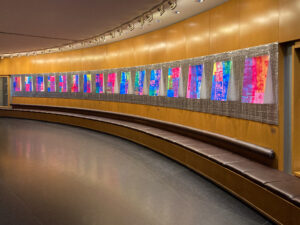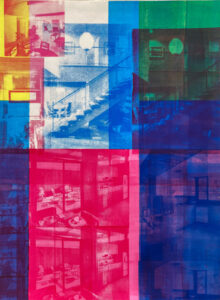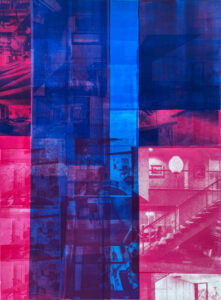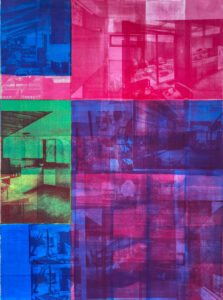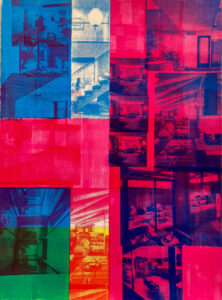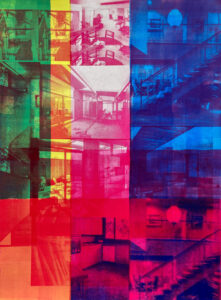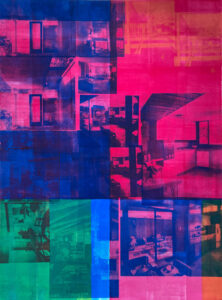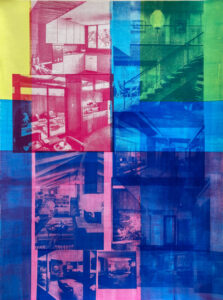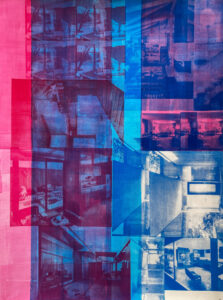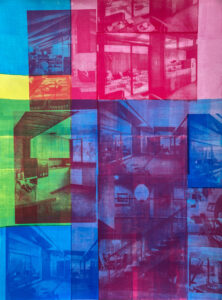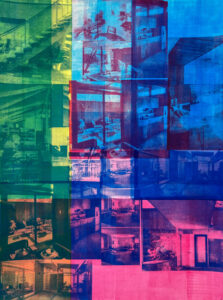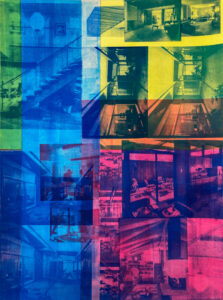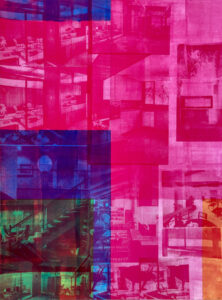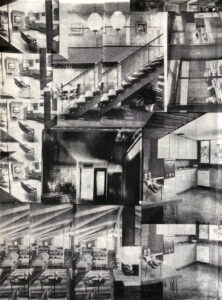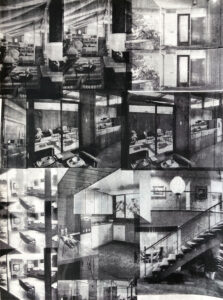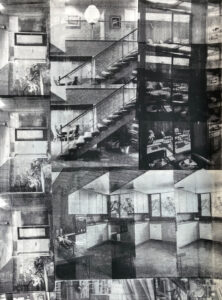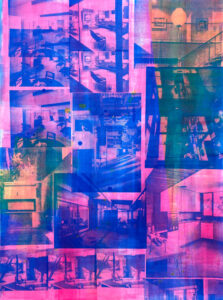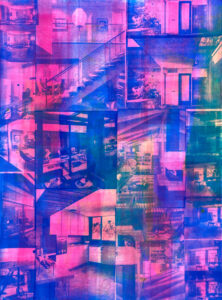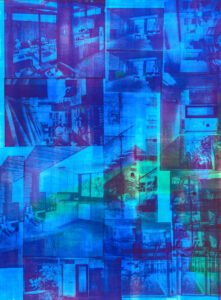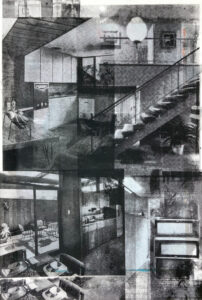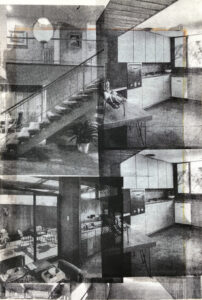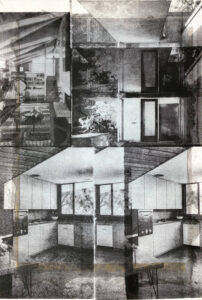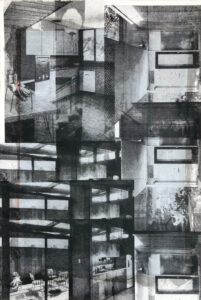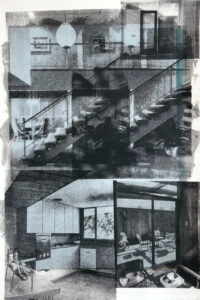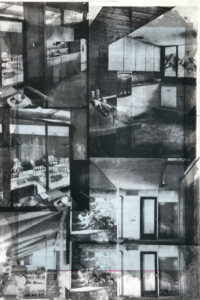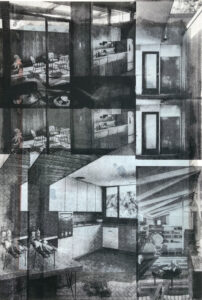This series of screenprints connects several senses of “construction”: A constructivist work of art, home building as construction, and the construction of the ideal of homeownership as the centerpiece of middle-class values (both as it was initially constructed in mid-century America, and as it is nostalgically reconstructed in contemporary discourse).
While the “American Dream” has a multitude of subjective meanings, home ownership is, for many, a nearly defining feature. In postwar America, rapid economic growth was paired with an expansion of the middle class. A single detached house was arguably the most highly desired product available in the consumer culture that emerged in response to the growing affluence of the middle class.
In the first decade after World War II, large-scale tract housing in subdivisions carved out of the countryside on the outskirts of major cities provided homes for the millions of recently returned veterans who wished to start new families. They could afford to buy houses thanks to generous government support from programs such as the GI Bill. The allure of the “new” (new technology, new materials, new styles, new ideas) at the heart of midcentury consumer culture ensured strong consumer demand for freshly-built houses. Critically, the automobile and its surrounding infrastructure (newly-built highways, ample parking) made it possible for the family breadwinner to live in the suburbs and commute to the city for work. Tract housing was, for the first time at this scale, built via the same principles of mass production that Henry Ford had developed for the automobile industry.
The period of interest in this work comes a decade later, when many of those families who had purchased small starter homes were looking to upgrade to a larger house with newer materials and modern conveniences. Lots were a bit larger, and privacy (which was scarce in earlier tract housing), offered through features such as courtyards, attached garages, and rear-facing living rooms, became a selling point. Some facets of modernist architecture were also becoming incorporated, for the first time, in mainstream retail housing construction, as is discussed further below.
By the mid-1950s, more sophisticated marketing strategies had developed in tandem with the growth of the middle-class housing market. The most elaborate, and popular, of these new strategies was the model home. Initially, the idea was to build a home that the prospective purchasers could walk through, so that they no longer had to rely on blueprints and imagination. Over time, the strategy was enhanced to include furnishing the model home, landscaping its lot, and, ultimately, setting it in a fully paved model neighbourhood that showcased different home models.
In this project I focus on the model home, because it was developed as a concrete manifestation of the key selling points, the “value proposition,” associated with the marketing of the (often aspirational) new home to the middle class. That idea of the new home was an idealization even then, of course, but many of the associated values and visual features that were embodied in the model home continue to resonate today. In other words, the midcentury model home was a kind of fiction. It reflected a set of middle-class values. When we look back, now, on that era in American history, much of what we “remember” is filtered through the lens of these values and images. When we think of what life was like “back then,” we might be thinking more about the model home than about the real home life of a typical American at that time.
For that reason, it is instructive to consider the marketing logic that guided the strategic presentation of the model home. For instance, model homes were often full of upgrades that made them more expensive than the typical home for sale in the neighbourhood that was under construction. Consultants were brought in to advise on upscale furnishings for the model home that would appeal to a broad segment of customers. Many of these marketing techniques remain in use today, attesting to their effectiveness.
House & Home was a trade magazine aimed at merchant builders (home design and construction firms that built multiple units, typically on newly-developed land). Started in 1952, it was an offshoot of Architectural Forum, which continued to cater to more traditional custom builders. Every year, House & Home published an issue dedicated to merchandising (or what we would now call marketing). Model homes featured prominently in these issues, with successful merchant builders sharing tips on what had boosted sales for them.
My project uses images of model homes taken from the annual marketing issues of House & Home published between 1952 and 1967. In contrast to images from consumer magazines, such as Life, what I find compelling about the images in House & Home is how explicitly they are focused on execution of a marketing message. In this way, arguably, we see a highly distilled representation of midcentury American middle-class values and desires as targeted, and shaped, by the housing industry. The model home was idealized, and literally uninhabited; there are no people in the images I use in this work. While these images reflect the genuine desires and aspirations of the consumers the model homes were built to attract, they are now, for many of us, closely associated with the sense of optimism and faith in technological progress that is a hallmark of that era, at least as seen from our current-day perspective.
The way we respond, today, to these images and the associations they bring to mind, inevitably involves comparison: How is life different for the typical American or Canadian today than it was back then? Highly idealized images of the midcentury American lifestyle make it easy to feel nostalgic for this not-so-distant past. And that nostalgia can play a potent role in political discourse. Most notoriously, autocrats derive power for their nationalist platforms by invoking a past golden age that was lost due to the erosion of traditional values (often blamed on immigration). But nostalgia can also be invoked for progressive purposes, as when we point to the postwar era as one in which workers shared the proceeds of economic growth, before the investor class began to capture a growing share of those proceeds starting in the 1970s.
A distinguishing feature of homes built in the period I’m focusing on is the introduction of what we would now call modernist features. Clean lines, simple geometric forms, and a general flatness became more prevalent design elements in residential architecture, landscaping, and furniture in the 1950s and 1960s. Modernism, which had stood at the avant garde of the art world a half century earlier, and at that time acquired its cultural association with newness and progress, now entered the consumer culture of the middle class. Indeed, a throughline can be traced from Russian Constructivists at the turn of the century through the Bauhaus to the International Style in American skyscraper architecture, all of which served to replace craft and ornamentation with functional industrial materials, and baroque complexity with simple box forms.
Merchant builders in the 1950s and 1960s encouraged middle-class consumers to upgrade to a newly-constructed house by emphasizing the benefits of new materials and technologies that came with these houses. Modernism, as a style, then, became emblematic of “the new,” symbolizing progress through technology toward better living. Large windows that acted almost as glass walls, sleek minimalist furniture, radically simplified box-shaped houses (sometimes with flat roofs), open floorplans: These features that had been prominent for some time in high-end, architect-designed, custom-built houses now became available to middle-class consumers purchasing a mass-produced home who aspired to be part of the emerging modern age.
Today, we view the products of this time through a lens of nostalgia. What we now refer to as the “midcentury modern” aesthetic is coveted for its retro appeal to a (seemingly simpler) time when what was new made us optimistic that even better things were coming through technology. As our faith in progress and technology has dwindled, or at least become more ambivalent, we may envy those midcentury Americans their (now almost touching) faith in a better, brighter future for all.
Faith in the new was faith not just in superior synthetic materials but more generally in the rationality of industrial processes and information systems. Even societal problems were thought to have technocratic solutions. Fordism provided a model for housing the expanding and increasingly affluent middle class, wedding the efficiency of mass production with the development of improved materials, modern design principles, and technological advances in home appliances.
The idea of an industrial assembly process was applied in the construction of this series of works on paper. The goal was to develop a structured system for art production in the form of a governing process that determines “look and feel” or background structure of the pieces. As a result, the works in the series are connected by a “family resemblance,” that is, a sense that the pieces share some common structure even if the specifics of the process by which they are produced is not understood in any detail. This property also characterizes the planned neighbourhood built by merchant builders, which might include houses that are distinct but share a common aesthetic; indeed, the modern planned neighborhood, with its tasteful and rational building layouts, became a differentiating selling feature.
We could also interpret the structure behind the works in this series as a kind of scaffolding on which components are hung, following a modular assembly process, much like those deployed in the new mass production model of retail home building. In fact, the series connects several senses of “construction”: A constructivist work of art, home building as construction, and finally the construction of the ideal of homeownership as the centerpiece of middle-class values (both as it was initially constructed in midcentury America, and as it is nostalgically reconstructed in contemporary discourse).
A final point of commonality between the production of this series and merchant home building lies in its use of industrial tools, and in construction that follows planned specifications. The industrial tools in this case, specifically, are for ink application: rulers, rollers, squeegees and screens, as contrasted with tools such as brushes that traditionally involve, and show, more of the artist’s hand. The color block backgrounds were applied with these tools and were positioned to adhere to a pre-specified plan (or “blueprint”). The archival images from House & Home were applied more intuitively but still using industrial techniques (screen print) and CMY process colors typically used in commercial printing.
